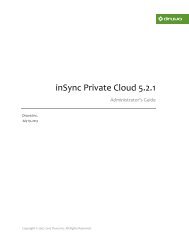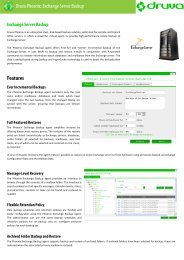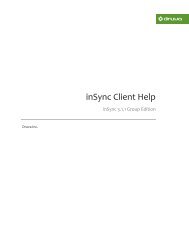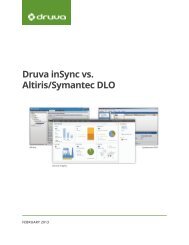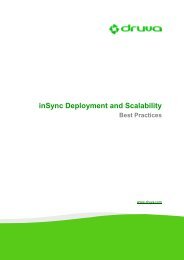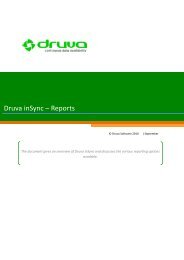inSync Private Cloud 5.2 - inSync Help - Druva
inSync Private Cloud 5.2 - inSync Help - Druva
inSync Private Cloud 5.2 - inSync Help - Druva
You also want an ePaper? Increase the reach of your titles
YUMPU automatically turns print PDFs into web optimized ePapers that Google loves.
<strong>inSync</strong> <strong>5.2</strong> <strong>Private</strong> <strong>Cloud</strong> – Administrator’s Guide<br />
To include folders that are not part of the default list provided by <strong>inSync</strong>:<br />
1. On the Laptop Backup Content tab, click Add. A folder is added under Folders and new fields<br />
related to the new folder are displayed under the tab.<br />
2. In Folder to be backed up, type the path of the folder that you want to backup.<br />
Note: You can add folders with relative paths including global variables<br />
like %appdata%, %username%, %homedir%, or %userprofile% in the path. These variables will be<br />
dynamically expanded to absolute path when applied on the client side.<br />
3. To change the name given by <strong>inSync</strong> to the new folder, type the name of your choice in <strong>inSync</strong><br />
Id for the folder. The name must be enclosed inside double braces{{name}}.<br />
4. To make it mandatory for <strong>inSync</strong> to backup this folder, select Mandatory folder. If you do not<br />
select this option, users will be able to remove this folder from being backed up by <strong>inSync</strong>.<br />
5. If you expect the folder to contain more than 10,000 files, or if you are backing up an entire<br />
drive, select Optimize for large number of files.<br />
6. Under Include Files, enter the files and file formats that you want to be backed up.<br />
85



